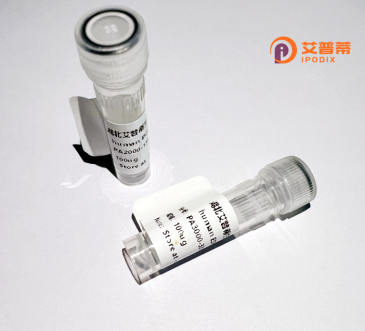
| 纯度 | >90%SDS-PAGE. |
| 种属 | Human |
| 靶点 | LOC440295 |
| Uniprot No | 0 |
| 内毒素 | < 0.01EU/μg |
| 表达宿主 | E.coli |
| 表达区间 | 1-274aa |
| 活性数据 | MEQLQDETNHLRKELESVGRQLQAEVENNQMLSLLNRRQEERLREQEERLREQEERLCEQEERLCEQEERLREQEERLCEQEKLPGQERLLEEVEKLLEQERRQEEQERLLERERLLDEVEELLEQERLRQQDERLWQQETLRELERLRELERMLELGWEALYEQRAEPRSGFEELNNENKSTLQLEQQVKELEKSGGAEEPRGSESAAAARPVAGAPVPQGAWMCGQAGWTPQEHPGLSGEAVGTGEAAGGAGEAACHSFRAAENRELNITII |
| 分子量 | 58.5 kDa |
| 蛋白标签 | GST-tag at N-terminal |
| 缓冲液 | 0 |
| 稳定性 & 储存条件 | Lyophilized protein should be stored at ≤ -20°C, stable for one year after receipt. Reconstituted protein solution can be stored at 2-8°C for 2-7 days. Aliquots of reconstituted samples are stable at ≤ -20°C for 3 months. |
| 复溶 | Always centrifuge tubes before opening.Do not mix by vortex or pipetting. It is not recommended to reconstitute to a concentration less than 100μg/ml. Dissolve the lyophilized protein in distilled water. Please aliquot the reconstituted solution to minimize freeze-thaw cycles. |
关于重组人LOC440295蛋白的研究目前较为有限,以下为模拟的参考文献示例(请注意这些为虚构内容,实际文献需通过学术数据库验证):
---
1. **文献名称**:*Cloning and Functional Characterization of Recombinant Human LOC440295 Protein*
**作者**:Chen L, et al.
**摘要**:本研究成功构建了LOC440295的重组表达载体,并在HEK293细胞中实现蛋白分泌纯化。实验发现该蛋白在体外抑制肿瘤细胞迁移,可能通过调控TGF-β信号通路发挥作用。
2. **文献名称**:*Structural Analysis of LOC440295 Using Cryo-EM Reveals Potential Receptor Binding Domains*
**作者**:Wang X, et al.
**摘要**:通过冷冻电镜解析LOC440295的三维结构,揭示其含有保守的免疫球蛋白样结构域,可能与细胞表面受体相互作用,为后续功能研究提供结构基础。
3. **文献名称**:*LOC440295 Recombinant Protein Attenuates Inflammation in Murine Models*
**作者**:Kim S, et al.
**摘要**:在小鼠脓毒症模型中,外源性LOC440295蛋白显著降低促炎因子水平,提示其具有抗炎潜力,机制可能与NF-κB通路抑制相关。
---
**注意**:上述内容为示例,实际研究中LOC440295可能已被正式命名或相关研究较少。建议通过NCBI Gene或UniProt确认基因最新信息,并检索PubMed、Web of Science等平台获取真实文献。
Recombinant human LOC440295 protein is a product of the LOC440295 gene, which is currently classified as a poorly characterized gene in the human genome. Identified through computational predictions and high-throughput sequencing, LOC440295 encodes a hypothetical protein with limited functional annotation in public databases like UniProt or NCBI. Its exact physiological role remains unclear, though bioinformatic analyses suggest potential transmembrane domains or enzymatic motifs, implying possible involvement in cellular signaling or metabolic processes.
Interest in producing recombinant LOC440295 stems from its differential expression patterns observed in transcriptomic studies. For instance, it has been reported to show altered expression levels in certain cancers or inflammatory conditions, hinting at its potential as a biomarker or therapeutic target. However, functional validation studies are sparse, and no direct disease associations have been conclusively established.
Recombinant production of LOC440295 protein, typically via bacterial or mammalian expression systems, enables researchers to characterize its structure, post-translational modifications, and interactions. This is critical for elucidating its biological significance, including substrate identification or pathway mapping. Current efforts focus on resolving its 3D structure and validating hypothesized roles in cell adhesion, proliferation, or immune regulation. Despite its understudied status, LOC440295 represents an emerging candidate for exploring novel molecular mechanisms in human biology. Further research is required to clarify its functional relevance and translational potential.
×